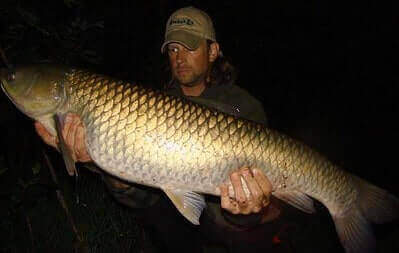Disclosure: We may earn commissions if you purchase products after clicking on a link from our site.
Do you want to learn how to catch grass carp in a pond? If so, you have come to the right place! In this article, we will provide you with everything you need to know to be successful in your quest to catch a grass carp. We will discuss the fishing methods, which bait to use, how to set up your fishing gear, and how to spot these elusive fish.
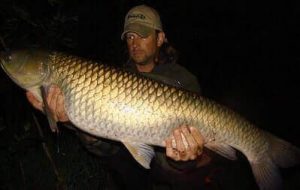
Table of Contents
How To Catch A Grass Carp In A Pond
1. Fly Fishing
Fly fishing is a fishing method often used by anglers to fish for grass carp. Cast your line and leave some slack in the line. When the line begins to tighten, set the hook and hold on to the line. Grass carp have the tendency to make long runs when it is hooked. The little slack in the line will help to keep the carp on the line.
2. Baiting
One fishing method used by anglers to catch grass carp is baiting an area for grass carp. Anglers usually put bait like corn, about 5 to 10 cans, in the water about 10 to 20 feet from the shore. Don’t bait an area that has a brush, other vegetation, or structures that can prevent you from getting the fish.
Soak the corn in water for a number of days to get it to ferment before you dump it into the water. Live earthworms and bread dough balls are other bait that can be used to bait grass carp.
Grass Carp Fishing Equipment
1. Medium-Heavy Fishing Rod
When targeting grass carp, having the right fishing rod is crucial for success. Typically, anglers opt for longer and more flexible rods to handle the power and agility of these hard-fighting fish. A fishing rod designed for grass carp fishing should be sensitive enough to detect subtle bites yet strong enough to handle the weight and power of a large carp.
Many anglers prefer rods with medium to medium-heavy action, which provides the necessary backbone to control the fish during the fight while still allowing for a good presentation of bait or lures. Additionally, a longer rod, typically ranging from 7 to 9 feet in length, helps anglers cast further and maneuver bait around vegetation where grass carp often feed. With the right fishing rod in hand, anglers can effectively target and land grass carp with confidence and precision.
2. Small Hook
When targeting grass carp, using a small hook can be an effective strategy for enticing these cautious feeders. Grass carp are known for their tendency to nibble at bait before fully committing, so a small hook allows for better hook penetration and increases the chances of a solid hookup.
Anglers often opt for hooks in the size range of #6 to #10, depending on the size of the bait being used and the preferences of the fish in the specific fishing location. Using a small hook also helps present the bait more naturally, reducing the chances of spooking wary grass carp.
Additionally, smaller hooks are less likely to cause injury to the fish, promoting ethical catch-and-release practices. Overall, incorporating a small hook into your tackle setup can greatly improve your chances of success when targeting grass carp.
3. Reel
When targeting grass carp, selecting the right fishing reel is crucial for effectively handling these powerful fish. Opting for a reel with a smooth drag system is essential, as grass carp are known for their strong runs and spirited fights once hooked.
A spinning reel or baitcasting reel with a sturdy construction and a reliable drag mechanism is typically preferred by anglers pursuing grass carp. The reel should have enough line capacity to accommodate the long runs that grass carp often make when hooked, helping to prevent line breakage and ensuring a successful landing.
Additionally, a reel with a high gear ratio can be advantageous for quickly reeling in slack lines and keeping up with the fast-paced action of battling a grass carp. By choosing a well-suited fishing reel, anglers can enhance their chances of successfully hooking and landing these elusive freshwater giants.
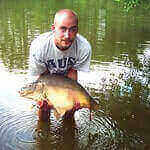
4. Landing Net
When targeting grass carp, having a landing net is an essential piece of fishing gear that can greatly improve the angler’s success rate. Grass carp are known for their size and strength, often putting up a spirited fight when hooked.
A landing net allows anglers to safely and efficiently land these powerful fish without risking injury to either the fish or themselves. When selecting a landing net for grass carp fishing, it’s important to choose one with a large hoop size and a deep, soft mesh to ensure that it can accommodate the size of the fish and prevent the hook from becoming entangled.
Additionally, a sturdy handle and frame are essential for effectively handling the weight and thrashing of a hooked grass carp. With a reliable landing net by their side, anglers can confidently pursue grass carp knowing that they have the necessary equipment to safely land their prized catch.
5. Fishing Line
A strong and durable fishing line is indispensable gear for grass carp fishing, as these fish are known for their powerful runs and ability to put up a fight. When targeting grass carp, anglers typically opt for monofilament or braided fishing lines due to their high strength and abrasion resistance.
Monofilament lines are popular for their stretch, which can help absorb the shock of a grass carp’s sudden movements, while braided lines offer excellent sensitivity and strength, allowing anglers to detect even the slightest bite and withstand the brute force of a hooked fish.
The choice of fishing line strength depends on the size of the grass carp being targeted and the fishing conditions but typically ranges from 10 to 20-pound test for smaller fish and up to 30-pound test or more for larger specimens. A reliable fishing line is crucial for successfully landing grass carp, ensuring that anglers have the strength and resilience needed to bring these hard-fighting fish to shore.
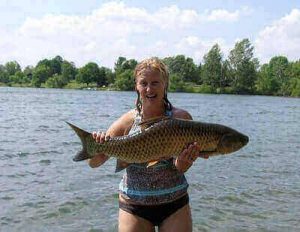
Grass Carp Fishing Bait
Grass carp is a herbivorous fish. They eat mainly aquatic plants at the bottom of ponds and lakes. Here are some of the main items that can be used as bait to fish for grass carp.
1. Sweet Corn
Sweet corn is a highly effective bait for targeting grass carp, renowned for its natural sweetness and bright color that appeals to these herbivorous fish. Grass carp, often found in freshwater lakes, ponds, and rivers, are known to feed on a variety of vegetation, including aquatic plants and grasses.
Sweet corn mimics the appearance and taste of their natural food sources, making it a preferred bait among anglers seeking to lure these elusive fish. Whether used fresh, frozen, or canned, sweet corn can be easily threaded onto fishing hooks or incorporated into rigs such as hair rigs or method feeders.
When presented in the water, the scent and visual appeal of sweet corn can attract grass carp, enticing them to feed aggressively. Anglers often find success by fishing sweet corn near weed beds, submerged vegetation, or other areas where grass carp are known to forage, making it a go-to bait for those targeting these prized freshwater species.
2. Cherry Tomatoes
While unconventional, cherry tomatoes can serve as an effective bait for enticing grass carp. These vibrant, bite-sized fruits possess a natural sweetness and bright color that can appeal to the herbivorous tendencies of grass carp.
When targeting grass carp, anglers often experiment with various baits, and cherry tomatoes can be a surprising yet successful choice. Anglers typically rig the cherry tomatoes onto hooks using methods similar to those used for other bait types.
Additionally, cherry tomatoes can be paired with other bait options or used as part of a diverse bait spread to increase the likelihood of attracting grass carp. When presented in the water, the scent and visual appeal of cherry tomatoes can pique the interest of grass carp, encouraging them to investigate and potentially strike. While not a traditional bait choice, cherry tomatoes can offer a unique and effective approach for anglers targeting these elusive freshwater species.
3. Watermelon
Watermelon, though primarily known as a refreshing summer fruit, can also double as an effective bait for targeting grass carp. Its juicy, sweet flesh and high water content make it an enticing option for these herbivorous fish.
Anglers often use watermelon as bait by cutting it into chunks or slices and placing it on fishing hooks or rigs. When submerged in the water, the scent of the watermelon can disperse, attracting nearby grass carp with its aromatic allure. The vibrant color and texture of watermelon can also catch the attention of these fish, prompting them to investigate and potentially strike.
Additionally, watermelon can be combined with other bait options or used as part of a diverse bait spread to increase its effectiveness. Overall, watermelon serves as a unique and natural bait choice for anglers seeking to hook grass carp in freshwater environments.
4. Earth Worms
Earthworms, a classic bait choice for many anglers, can also be effective when targeting grass carp. While grass carp primarily feed on aquatic vegetation, they may opportunistically consume small invertebrates like earthworms.
Anglers often use earthworms for grass carp by threading them onto fishing hooks or presenting them on the bottom near areas where grass carp are known to feed. The wriggling motion of earthworms in the water can attract the attention of grass carp, enticing them to investigate and potentially strike.
Additionally, earthworms emit natural scents and flavors that can appeal to grass carp, making them a reliable bait option. When fishing for grass carp with earthworms, anglers should consider using larger-sized earthworms to match the preferences of these sizable fish. Overall, earthworms provide a versatile and readily available bait option for anglers targeting grass carp in freshwater habitats.
5. Dough Balls
Dough balls, a tried-and-true bait option, can also be effective for enticing grass carp. These simple yet versatile baits are made by mixing flour, water, and various additives to create a doughy consistency that can be easily molded into balls or other shapes.
Anglers often enhance dough balls with additional attractants such as vanilla extract, corn syrup, or other sweet flavors to increase their appeal to grass carp. When fishing with dough balls for grass carp, anglers typically mold the bait around a fishing hook, ensuring it stays securely attached during casting and retrieval. The scent and texture of the dough balls mimic natural forage, enticing grass carp to feed.
Additionally, the buoyancy of dough balls allows them to float just above the bottom, where grass carp commonly forage for food. Anglers can present dough balls near aquatic vegetation or other areas where grass carp are known to frequent, maximizing their chances of success. Overall, dough balls offer anglers a convenient and effective bait option for targeting grass carp in freshwater environments.
6. Bread
Bread, a pantry staple for many, also serves as a surprisingly effective bait for catching grass carp. Whether it’s a slice of sandwich bread, a dinner roll, or even stale bread, grass carp are attracted to the texture, scent, and taste of this common food item.
Anglers often utilize bread as bait by tearing or cutting it into small pieces and then either molding it around a hook or using it as chum to attract grass carp to a specific area. The soft texture of bread allows it to easily adhere to a hook or float on the water’s surface, making it an enticing option for grass carp feeding near the top of the water column.
Additionally, bread can be combined with other baits or attractants to enhance its effectiveness, such as soaking it in a solution of sweetened water or fish attractant. Whether fishing from the shoreline or a boat, anglers can cast bread out into the water or present it near areas where grass carp are known to congregate, such as along the edges of aquatic vegetation or near submerged structures. Overall, bread offers anglers a readily available and versatile bait option for targeting grass carp in freshwater environments.
7. Lima Beans
Lima beans, typically enjoyed as a nutritious side dish, can also double as effective bait for enticing grass carp. These legumes possess a combination of visual appeal and scent that can attract the attention of these herbivorous fish.
Anglers often use lima beans as bait by threading them onto a fishing hook or attaching them to a bait rig. The soft texture of lima beans allows them to stay securely on the hook, ensuring they remain attractive to grass carp.
Additionally, lima beans can be flavored or enhanced with other attractants to increase their effectiveness, such as soaking them in a solution of fruit juice or fish oil. When fishing for grass carp, anglers can cast their baited hooks into the water near areas where grass carp are known to feed, such as along the edges of weed beds or near submerged structures.
As the lima beans sink to the bottom or drift along with the current, they emit enticing scents that can draw in curious grass carp. Overall, lima beans offer anglers a natural and readily available bait option for targeting grass carp in freshwater environments.
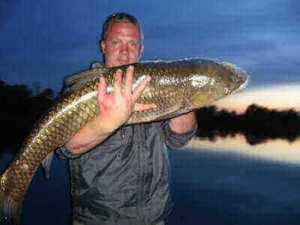
Grass Carp Fishing In A Pond Tips
1. Start fishing for grass carp in lakes and ponds. Grass carp is a non-native species brought to the United States from Asia. They were brought to control the growth of aquatic plants in reservoirs, fish farms, and other areas. You can learn more about how to fish a pond from this article.
Today, they are in ponds and private lakes to control vegetation. Always ask permission from the landowner before you start fishing on someone’s pond.
2. Use a 7-foot medium-heavy, fast-action rod. It provides the sensitivity needed to feel the bite of the grass carp. Additionally, use a medium spinning reel with a medium gear ratio. Maintain a loose drag to allow the fish to run without line breakage.
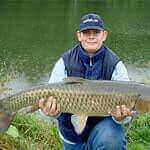
3. It is important that you use the right tackle. You will need up to 20-pound test monofilament or fluorocarbon rigged with a 1/0 or 2/0 size to a bait circle hook.
4. Implement chumming. About 4 days before you go out to fish an area, throw corn in the shallows of the water to attract the grass carp. The fish will come to that area expecting more corn. On the day you go out to fish the water, grass carp will be in that area expecting more corn.
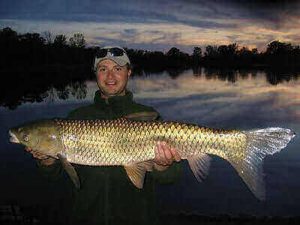
5. Spoiled corn, bread dough balls, and live earthworms are some of the most successful bait for grass carp.
6. Let the reel spool freely. If there is any resistance, grass carp will drop the bait. Let the line remain slack until they eat the bait, then slowly reel the slack in and set the hook.
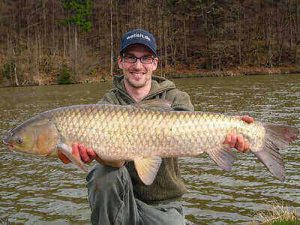
7. Grass carp is cautious and can easily be spooked. They can see outside the water and are very suspicious of movement or sound. Walk and speak quietly and lightly as you approach the river. Dress so that your colors blend with the area. Additionally, cast gently. A BB split shot or slip sinker is the best option.
8. You can stalk the fish if the pond or lake is clear to the point that you can see and watch them take the bait.
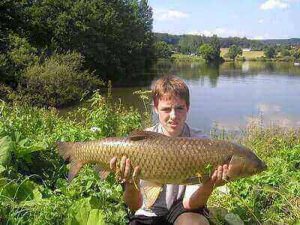
9. Areas of the lake and ponds with a lot of vegetation are the best spots to look for grass carp.
10. When the sun is overhead and the waters are warm is the best time to fish for grass carp. They will move to the top to find something to eat or just enjoy the warm weather.
11. Be alert and remain calm. Grass carp will put up a vicious fight when it realizes it is hooked. You should just remain calm and buy for time so it wears itself out. This is why quality equipment is so important for grass carp fishing. Make sure there is no hole for it to escape. Maintain a firm grip and keep watching it. When it gets tired, get your net and get it.
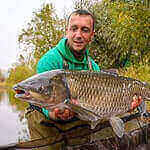
12. Patience is key. You have to develop the patience to fish for grass carp. If they become spooked, you will have to wait for some time for them to relax and let their guard down again. They will not come running to your bait when you put it out there, even if they are hungry. They will observe it, sniff and nibble it to check it out before giving it a bite. Remain calm and be patient.
13. Cast carefully. Slowly and gently cast to avoid a big splash. Avoid fast reeling or other water disturbances. Practice casting until you are comfortable with it if you are a beginner.
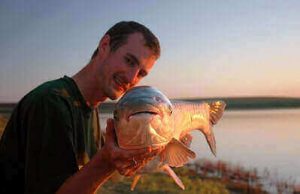
14. Grass carp can be very destructive to an ecosystem and it is sometimes intentionally introduced into an area to control the weeds like in a pond.
The Bottom Line
How to catch a grass carp in a pond may seem challenging but it is very exciting and rewarding. In this article, we discussed how to catch grass carp in a pond. We hope that these grass carp fishing tips will help you catch more grass carp and be a better angler.
You can be more successful when fishing for catfish with tips for this article on catfishing tips. You can also read how to fish for koi, and how to bowfish.
